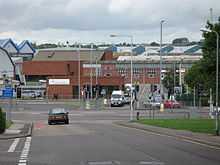W.E.W. Petter
| W.E.W. (Teddy) Petter | |
|---|---|
| Born |
8 August 1908 Highgate, north London |
| Died |
1 May 1968 Béruges, France |
| Nationality | British |
| Education | Gonville and Caius College, Cambridge |
| Spouse(s) | Claude Munier |
| Children | 3 daughters |
| Parent(s) | Sir Ernest Willoughby Petter |
|
Engineering career | |
| Engineering discipline | Aeronautics |
| Employer(s) | Westland Aircraft, English Electric, Folland Aircraft |
| Significant design | Westland Lysander, Folland Gnat |
| Significant advance | Canberra, Lightning |
| Significant awards | John Bernard Seely Prize for Aeronautics, Royal Aeronautical Society silver medal[1] |
William Edward Willoughby "Teddy" Petter BA,FRAeS,CBE (8 August 1908, Highgate in Middlesex - 1 May 1968, Béruges) was a British aircraft designer. He is noted for Westland's wartime aeroplanes, the Canberra, the early design of the Lightning, and his last plane, the Folland Gnat.
Early life
Edward 'Teddy' Petter was the oldest of the three sons and one daughter of Sir Ernest Petter (co-founder of Westland Aircraft Works) and his wife, Angela Emma. Because his father spent much time in London, Teddy's early childhood was spent mostly with his mother, from whom he inherited a strong religious conviction and firm ethical principles.[2] He was educated at Marlborough College in Wiltshire then Gonville and Caius College, Cambridge. During his first two years at Cambridge he focused his studies on subjects relevant to oil engines, the traditional product of Petters Limited, but in his third year he concentrated on on aerodynamics and aircraft engineering.[3] In 1929 he was awarded a first class in the mechanical sciences tripos and shared the John Bernard Seely prize in aeronautics.[1]
Career

Westland
Petter joined Westland Aircraft Works as a graduate apprentice in 1929 and for the next two and a half years he worked in every department, not seeking any favour despite being the chairman's son.[4] In the drawing office it was noted that he was a very poor draftsman but had good ideas. [5][6] Years later he said "I looked on this as sheer drudgery at the time, but knew afterwards that without workshop knowledge I would never have become a designer".[7]
In May 1932 he was appointed as personal assistant to the managing director, Robert Bruce, a position previously held by his friend and colleague Harald Penrose. [6] Bruce did not welcome the appointment and ignored him, leaving Petter spare time to modify and compete an Austin 7. [7] Despite his interest in sports cars, Petter had no interest in learning to fly. Penrose gave him a flying lesson at this time, but later commented that Petter had a 'lack of the requisite sensitivity coupled with hopeless judgment of speed and distance'.[6]
His father appointed Petter to the board in May 1934, making him technical director (at the age of 26) in preference over more experienced engineers such as Arthur Davenport and Geoffery Hill. This was not welcomed by the older members of the management, ultimately prompting Bruce and Hill to resign, and placing the older and more experienced Davenport in an intolerable position as his subordinate.[8] One of his first actions as technical director was to terminate development of Hill's Pterodactyl, a pioneering tailless swept wing aircraft.[9][10]
However, other business decisions by Ernest Petter infuriated Teddy. In July 1935 Ernest Petter convened a shareholders meeting to propose a merger with British Marine Aircraft for the purpose of expanding Westland's workshops.[Note 1] This proposal was thwarted by Teddy and Peter Acland who threatened to resign. But In July 1938 Ernest Petter sold the controlling shares in Westlands to John Brown Ltd, forming Westland Aircraft Limited as a separate company. Teddy saw the loss of family control of the company as the loss of his birthright, and this dispute would divide the Petter family for years, not being resolved until shortly before Ernest Petter's death in 1954.[11]
The Air Ministry was initially reluctant to award Westland contracts due to Petter's inexperience, but his reputation as a successful designer was strengthened after it was demonstrated the automatic slats on the PV 7 were both effective and reliable. As a result, and after internal discussion, the Air Ministry added Westland to the list of bidders for Specification A.39/34 (the replacement for the Hawker Hector army co-operation aircraft).[12][13] Petter started the design by interviewing the Army Cooperation pilots and ground crew.[13] Based on this information, he placed pilot visibility, the ability to take off and land in small spaces, and ease of ground maintenance as the prime requirements. The resulting design, the Westland P8 (later named the Lysander), was clearly an evolution of Westland's high winged monoplane designs, but Petter incorporated a number of innovative features including extensive use of extruded sections throughout the airframe, something that would be a feature in his future designs. [14][15][16]
The early flight testing revealed attitude control problems that the wind tunnel tests had not predicted. Petter instructed Penrose to conceal these problems from Ernest Petter.[17] Later, when these problem had been addressed by a larger, variable incidence tailplane, it was realized that if a landing was aborted and the throttles opened up fully, the Lysander could rear up and stall. While Penrose and RAF test pilots lobbied for modifications, Petter refused because redesign would affect production.[18][19] Also, in his zeal to reduce weight, Petter had used glider fabric instead of specification Irish linen to cover the wings on the second prototype. This nearly caused a disaster when an RAF Pilot dived it to the limit, causing the fabric on the top surface to tear off.[20]
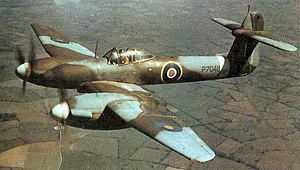
Petter's next plane was the twin-engined Whirlwind (which was one of the fastest aeroplanes in the world at the time). Not many were built. His last plane for Westland was the high-altitude twin-engine Welkin. It had a pressurised cockpit and was designed to intercept German reconnaissance aircraft. Around 100 were built. At this time Westland was mostly building Spitfires, under contract.
English Electric
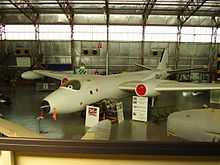
Petter left Westland in December 1944, after wanting to take over production as well as design. They chose to concentrate on helicopters through a link-up with Sikorsky.
He went to English Electric as Chief Engineer who were then moving into aircraft design, at Warton near Preston, having been involved in building aircraft under contract during the war. While at EE, under the leadership of George Nelson, he designed the Canberra. This plane was based on a Westland design for a jet bomber, created by Westland's Chief Engineer, Arthur Davenport. The aircraft would stay in operation in the RAF for 57 years until June 2006. In the United States, the Martin Company built the design under licence from 1953, as the Martin B-57, which was operated by the United States Air Force (USAF), NASA, the Pakistan Air Force and Taiwan Air Force. While the type was retired by the USAF in 1983, NASA still operates three.
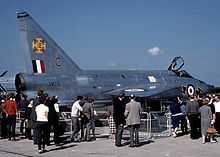
He started the work on what would become the Lightning. He split with EE in 1950 over the direction of aircraft design, he favouring the small over the large. He also wanted to be in charge of production as well as design. Petter was replaced as Chief Engineer by Frederick Page, previously his assistant.
The Lighting remains the only all-British Mach 2 aircraft. The plane has been described as "fifteen tonnes of screaming aluminium".
Folland Aircraft
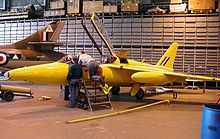
Petter joined Folland Aircraft Limited in Hamble, Hampshire as Chief Engineer in 1951, and took some colleagues from English Electric. At Folland, he designed the Midge, which first flew 11 August 1954, and the Gnat training jet (first flight 18 July 1955). He was also responsible for early work on the Red Dean air-to-air missile before this work was transferred to Vickers.[21] The Gnat was entirely his design; it was his attempt to make an affordable and easy-to-build fighter. He felt that other contemporary fighter aircraft were too big and expensive.
Petter became Managing Director of Folland in 1954 when Henry Folland died. Folland Aircraft was bought by Hawker Siddeley in 1959, which kept the Folland name until 1963. Petter left when Hawker Siddeley took over; he did not like working for large organisations, preferring to run projects himself. Colleagues found him authoritarian and eccentric - some described him as likeable but difficult. His manner was likened to that of a sixth form maths tutor. He was known as an excellent leader of teams, so long as things went as he wanted.
On leaving Folland / Hawker Siddeley, Petter left the aircraft industry completely. He moved to Switzerland.
Personal life
Petter had two younger brothers and a younger sister. He married and had three daughters (including two born in 1936 and 1938). He died in Poitou-Charentes in France aged 59. Petter married Claude Marguerite Juliette Munier, from Geneva. She died in 1975, having suffered for a long time from Parkinson's disease.
Patents
- US application 2841346, William Edward Willoughby Petter, "Jet-propelled aircraft", published 1958-06-01, assigned to Folland Aircraft Ltd
See also
Notes
- ↑ Ironically, British Marine Aircraft would become Folland Aircraft in 1937
References
Citations
- ↑ 1.0 1.1 Pimlott Baker (2004).
- ↑ Davies (2014), p. 13.
- ↑ New Scientist (1958), p. 620-621.
- ↑ Penrose (1984), p. 78.
- ↑ New Scientist (1958).
- ↑ 6.0 6.1 6.2 Penrose (1984), p. 112.
- ↑ 7.0 7.1 Davies (2014), p. 15.
- ↑ Penrose 1984, p. 137.
- ↑ Davies (2014), p. 16.
- ↑ Penrose (1984), p. 148-149.
- ↑ Davies (2014), p. 36.
- ↑ Davies (2014), p. 16-17.
- ↑ 13.0 13.1 Penrose (1984), p. 150.
- ↑ Flight (1938), p. 570-576.
- ↑ Davis (2014), p. 47.
- ↑ Penrose (1984), p. 151.
- ↑ Penrose (1984), p. 161.
- ↑ Penrose (1984), p. 162.
- ↑ Davies (2014), p. 29.
- ↑ Penrose (1984), p. 163.
- ↑ 'Folland', British Aircraft Directory (1 May 2004) Retrieved 20 May 2005
Cited sources
- Davies, Glyn (2014). From Lysander to Lightning Teddy Petter, aircraft designer. The History Press. ISBN 9780752492117.
- "Profile W.E.W Petter A man who learned patience". New Scientist 4: 620–621. 14 August 1958.
- Penrose, Harald (1984). Adventure with fate. Airlife.
- Pimlott Baker. "(William) Edward Willoughby Petter (1908–1968)". Oxford Dictionary of National Biography (online ed.). Oxford University Press. doi:10.1093/ref:odnb/35497. (Subscription or UK public library membership required.)
- "AN OUT-of-the-ORDINARY MILITARY AEROPLANE". Flight. 9 June 1938.
- The Guardian 11 September 1955, Page 5
- The Times 27 May 1968, Page 10
Origin of this Petter family in North Devon see "Some men who made Barnstaple..." Pauline Brain 2010
